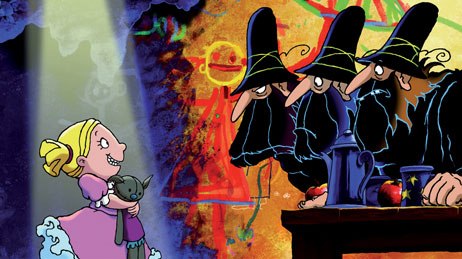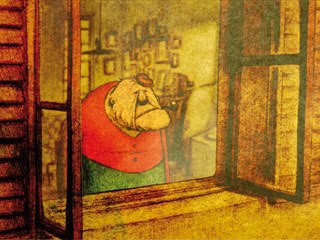At this year's festival, Philippe Moins sees the continuation of a trend toward more features and fewer short films.
Short personal films, the darling of all animation festivals, have seen their status somewhat diminished after the last Annecy festival.
Just three years ago, Annecy, like all festivals, tended to highlight short films, while giving the impression that features were there as an afterthought. A stepchild somewhat disdained by the artistic animation amateurs, features were long seen merely as commercial opportunities without any reason to exist apart from their box office potential.
Yet, since 1994, feature films have undergone a profound transformation into something more attractive, and this process continues into the present. Changed by the arrival of new technologies, certainly, but also by a diversification of subjects and a movement of small independent production companies toward producing blockbusters. Made more attractive because audiences have followed: each year more features are produced, and the line between genres is blurred. This is the case in the U.S., Europe, and Japan, but also more and more in other countries.
Following other festivals, Annecy decided, in 2006, to give more attention to features and, in the last two editions, the number of features entered in competition or simply screened at Annecy has increased substantially. The large number of prizes awarded in this category demonstrates that features no longer have any reason to fear artistic comparison with shorts. Notable prizewinners in this category were U and Max & Company. These films reconnected with audiences long ignored by animation's artistic elite, especially young audiences on whom the economic viability of animation has always depended.
In a reversal of the past two years, this year the Cristal award for best feature went to a film directed more toward adult audiences. Nina Paley's Sita Sings the Blues is a very personal work, full of charm, that goes back to 2D and simple and masterly compositing to tell a personal story, a sort of contemporary conjugal confession. Paley's inflections, which are clearly autobiographical, are not obscured by the director, but are rather openly exposed in the film. In mixing the Indian epic of Ramayana, songs from the 1920s and modern episodes, the director succeeds in drawing us into a story that's at once banal, yet touching. Nina Paley is a consummate animator who creates an empathy for the characters that resemble... models from an animation correspondence course. My only criticism: a too schematic editing style that reminds us that this is the director's first feature film.
Bill Plympton's Idiots and Angels (Special Mention) is by contrast the work of an established director, this being his fourth feature film. One feels that Plympton wants to show his audience that he is capable of providing more than simple amusement: a demonstration of the absurdity of existence through the abuse of the body is presented with a stylistic restraint that gives it its power. Plympton accumulates real-life gags and, despite all the irony, a kind of gravity emerges that is both desperate and full of life. And so, his old short films can appear in a new light: under the humor there was always a troubling aspect. Idiots and Angels will definitely not be appreciated by those who expect animation to go "boing boing" in every scene.
With Hayo Freitag's The Three Robbers (Audience Award), feature animation made for children is represented among the award winners, and it is a film worthy of recognition as long as one doesn't examine it too closely. Tomi Ungerer is a great illustrator and chances are that this septuagenarian feels a bit distant from a film very loosely based on one of his very short children's books.
Forgotten among the feature awards was Peur(s) du noir, an episodic French film that brings together several big names in international comic strips: Blutch, Charles Burns, Lorenzo Mattotti, Richard McGuire... For most of them, this was their first experience converting comics to animation and it proves satisfying, even exciting. But the principle of a film with several voices remains a difficult exercise and even here, where it has succeeded, this type of film had difficulty seducing an audience, let alone a jury.
In deciding to limit the showings of short features this year to four or five programs, Annecy gave a signal that did not escape notice, even if the number of school showings remained unchanged. Let us remember that during the last editions some people felt that the presence of certain short films in competition was not indispensable, and was even harmful on a group level. If this criticism had some foundation, it did not take into account the necessary heterogeneity of the selection committees: the product of their work almost always emerges from compromise, where very strong works inevitably aren't selected and where laboriously reached consensus sometimes lets mediocre films surface to the detriment of films around which there is less of a consensus. Thus screenings outside of competition are sometimes more "ballsy." Further, the extreme weariness resulting from viewing a large number of films can result in some incomprehensible eliminations, as well as some surprising inclusions.
This time, though, these four programs (which according to some could very well have been cut down to three!) make us wonder: too many films that were a little shallow, badly put together, not enough real discoveries. Is there really a crisis in the animated shorts category of animation? Do animated features work so well now because all of the most creative people are drawn there and have abandoned the short form? What then of the value of experimental shorts? Other selections in other places can partly reassure us of the healthy state of animation shorts.
Nevertheless, we must not be deceived: no longer dazzled by new technologies, short animation today is looking for a new raison d'etre. At festivals like Onedotzero or Nemo, a whole new inventiveness is brewing that rarely finds its way to the podiums of Annecy or elsewhere because those who make these films do not always want then to be categorized as "animation" and because story is rarely their primary concern.
The Annecy Cristal for short film, given to Kunio Kato for La maison en petits cubes crystallizes a certain malaise: beyond a well-known graphic ability, the films of this Japanese artist reveal a sort of conventionality for festivals. Nice, well-made, circumscribed -- in its esthetic, as in its writing, it could have been made 20 or 30 years ago. The question is whether this film is there because there really is nothing else, or because other more unsettling films are not the sort of films that win prizes at a large animation festival.
This year, none of the shorts that were selected had the power or intensity of Waltz with Bashir, the feature that opened the festival. This is clearly not an accident.
Translation by Leigh Jacoby.
Philippe Moins is writer and teacher in Belgium, and also co-director of the Brussels Animation Festival ANIMA.












